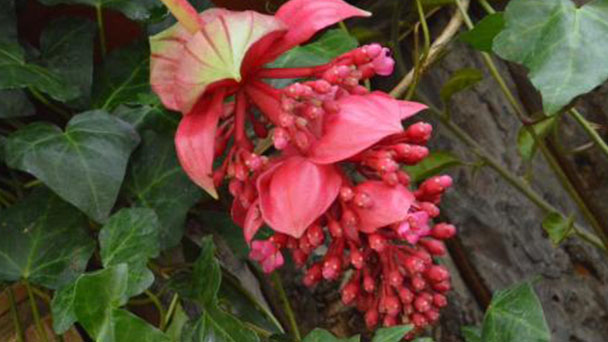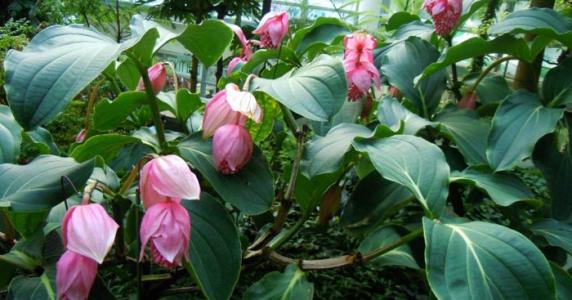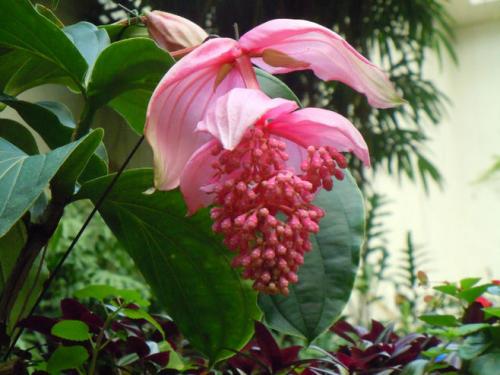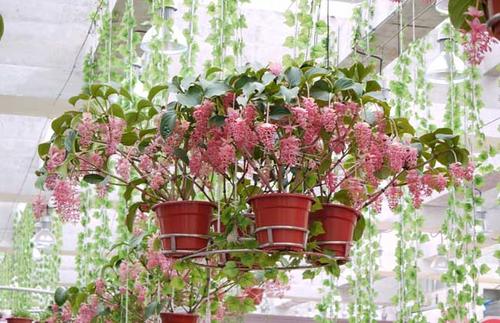Medinilla profile
Written by Maggie
Mar 08 2021

Medinilla, also known as showy medinilla or rose grape, is originally from the Philippines. Medinilla likes a high temperature wet and half shade environment, not cold, avoid scorching sun exposure, the requirement of fertile, loose leaf rot soil or peat soil, winter temperature is not less than 16℃.
Medinilla picture

Medinilla info
| Botanical Name | Mednilla magnifica |
| Common Names | Medinilla, rose grape, showy medinilla, Philippine orchid, pink lantern plant |
| Plant Type | Broadleaf evergreen |
| Light | Part shade |
| Native Areas | Phillipines, Java, Malay Peninsula, Sumatra. |
| USDA hardiness | 10 to 11 (USDA) |
| Flower color | Pink to coral red |
| Mature size | 2 to 4 feet tall; 1- to 3-foot spread |
Morphological characteristics of Medinilla
Medinilla is a pot plant up to 0.5-1 m tall, with large bright green oval leaves, opposite stems; Stem is four-prism, branching many; Large inflorescences are pendulous from branch tops, ca. 35 cm long, with red ovate bracts resembling lotus petals and clusters of small pink flowers forming pendulous large chandelier panicles.It can be used to decorate living rooms and dining rooms. The flowers and leaves of Medinilla are all beautiful, elegant and elegant, and the ornamental value is very high. It is the high-grade indoor potted ornamental flowers before and after the Spring Festival.
Medinilla's ecological habits
Medinilla is fond of high temperature, wet and semi-cloudy environments. It is not cold resistant and avoids sun exposure. Medinilla requires fertile and loose leaf rot soil or peat soil, and the temperature in winter is not lower than 16℃.
How to grow and care for Medinilla
Spring every year for the basin, remove the soil, increase fertile, good drainage leaf soil, appropriate shade. Keep the soil moist during the growing season and plant indoors in winter to increase light and reduce watering.Flowering period from April to June, humidity should not be too high, otherwise it is easy to cause falling flowers.
Pot or transplant
Seedlings plate or have several years of big plant pots, in pelvic floor in the first 2 ~ 3 cm thick coarse grained matrix as a filter layer, cover it with full of rotten organic fertilizer as basal, thickness of about 1 ~ 2 cm, then cover with a thin layer of substrate, about 1 ~ 2 cm thick, and then into the plant, in order to separate the fertilizer from the root, avoid burning roots.
Pour permeable water once after the basin, and put in a shade environment for maintenance for a week.
When the seedlings are transplanted, dig the planting hole first, and sprinkle a layer of organic fertilizer at the bottom of the planting hole as base fertilizer (base fertilizer), the thickness is about 4-6 cm, and then add a layer of soil and put the seedlings, to separate the fertilizer from the root system, to avoid burning the roots.
Put into the seedlings, backfill the soil, cover the root system, and foot the soil, pouring a permeable.
Moisture care
Medinilla likes a humid climate environment, the relative temperature of the air in the growth environment is required to be 70 ~ 80%, the relative humidity of the air is too low, the lower leaves yellowing, falling off, the upper leaves dull.
Temperature care
Because it is native to tropical areas, Medinilla likes high temperature and high humidity environments, the winter temperature requirements are very strict, when the ambient temperature is below 10 ℃ stop growing, and frost can not safely overwinter.
In the summer:
1. Strengthen the air convection, so that the body temperature can be emitted;
2. Put in the half shade, or give it shade 50%;
3. Spray it appropriately 2 ~ 3 times a day.
In the winter:
1. Move Medinilla to a bright indoor place for maintenance;
2. In the outdoor, available film to wrap it up for winter, but every two days in the noon when the temperature is higher to uncover the film to let it breathe;
Light care
Medinilla likes a half shade environment, in autumn, winter, and spring can give sufficient sunshine, but in summer it can shade more than 50%.
Put in indoor maintenance, put in the place that has bright light as far as possible, wait for a place like the sitting room with good daylighting, bedroom, study. After indoor maintenance for a period of time (a month or so), it is necessary to move Medinilla to the outdoor shade (winter heat preservation conditions) of the place for maintenance for a period of time (a month or so), so alternate.
Water care
For potted plants, in addition to adding organic fertilizer on the pot, in the usual maintenance process, but also to carry out appropriate fertilizer and water management.
Spring, summer and autumn care
These three seasons are the peak season for Medinilla growth. The fertilizer and water management cycle is in the order of "Huabao" -- "Huabao" -- "Huabao" -- "Qingshui". The interval period is about 1-4 days, and the interval period is shorter during sunny days or high temperatures, longer during cloudy days or low temperatures or no watering.
Winter care
In the winter dormant period, the main work is to control fertilizer and water. Fertilization and water management follows the sequential cycle of "Huabao" -- clean water -- clean water -- "Huabao" -- clean water -- clean water, and the interval period is about 3-7 days.
For Medinilla planted in the ground, according to the drought in spring and summer, apply 2 ~ 4 times of fertilizer water: first in the root neck outside 30 ~ 100 cm to open a circle of small groove (the bigger the plant, the farther from the root neck), groove width and depth are 20 cm. Sprinkle 25 ~ 50 jin of organic fertilizer, or 1 ~ 5 two particles of compound fertilizer (chemical fertilizer) into the ditch, and then pour on permeable water. After winter and before spring, apply fertilizer again according to the above method, but do not water.
Trim
Medinilla enters dormant or half dormant period in winter, wants a thin, disease insect, dead, too close to wait for the branch to cut off.It can also be combined with cuttings to finish the branches.
Potting and RepottingIf you grow your Medinilla in a container, the quality of the potting mix will deteriorate over time. If you notice your medinilla container staying moist more than a day after you watered it, it's time to repot with fresh soil.

Medinilla's propagation
Medinilla is mainly propagated by cutting and sowing.
Seed propagation
Seed selection
Before sowing, we must first select the seeds. The seeds of Medinilla are well chosen, which is directly related to the success of sowing.
It is best to choose the seeds of the harvest. The longer the seed is kept, the lower its germination rate will be.
The selection of full seeds, no incomplete or deformed seeds.
Choose seeds that are free of pests and diseases.
Disinfection
Disinfection consists of two concepts, one refers to the disinfection of the seed, and the other refers to the disinfection of the substrate used for sowing. The family is commonly used to seed disinfection 60 ℃ or so of hot water immersed in a quarter of an hour, and then reoccupy lukewarm water sprouts 12 ~ 24 hours.
The best way to disinfect the substrate used for sowing is to put it in a wok and heat it up, which will kill any insects and diseases.
Sprouting
Soak the seeds in warm water (about the same temperature as your face wash) for 12 to 24 hours, until the seeds absorb water and swell. For very common seeds that germinate easily, this job can be left out.
Sow
For by hand or other tools hard to clamp the tiny seeds, can put the toothpick wet with water, at the end of the stick a grain by a grain of the seeds on the surface of the substrate, the substrate 1 cm thick, then the planting flower pot into the water, the depth of the water for the flower pot 1/2 ~ 2/3, the height of the water soak up slowly (the method known as "basin leaching method"); For larger seeds that can be held by hand or with other tools, place the seeds directly into the substrate and seed them at 3 x 5 cm intervals. After sowing, the substrate was covered with 2 ~ 3 times the thickness of the seed. After sowing available sprayer, fine pore sprinkle sowing matrix quality wet, when the basin soil is slightly dry and then drenched, still pay attention to the strength of watering can not be too big, so as not to flush up the seeds;
Cutting propagation
Often in late spring and early autumn with the branches of the year for tender cuttings, or in early spring with the branches of the previous year for old cuttings.
Substratum
The nutrient soil that uses cuttage namely or the material such as soil of river sand, mud carbon. Family cuttings limited to the condition is difficult to get the ideal cuttings matrix, the use of this site has been prepared and disinfected cuttings matrix; Medium-coarse river sand is fine, but rinse with clean water several times before use. Sea sand and saline areas of river sand are not use, they are not suitable for the growth of flowers and plants.
Selection of cuttings
For tender cuttings, in late spring to early autumn when the plant growth is vigorous, the selection of the year as a sturdy branch cutting. After cutting off the branches, select the strong parts and cut them into sections 5 to 15 centimeters long, with more than 3 leaf segments in each section. When cutting cuttings, it should be noted that the upper cutting mouth is about 1 cm at the top of the top leaf section, and the lower cutting mouth is about 0.5 cm at the bottom of the bottom leaf section. The upper and lower cutting mouth should be flat (the knife should be sharp).
Carried on hard cuttings, in early spring after the temperature rise, the selection of a year's robust branches do cuttings.Each cuttings usually retains 3 ~ 4 segments, and the cutting method is the same as that of shoots cutting.
Other species of Medinilla
The Medinilla genus is diverse, so look for subtle differences as you explore the species. The plants and seeds most widely available with a little searching are M. magnifica, but other species worth researching include:
Medinilla cummingii: Often known as chandelier tree, this plant has dense flowering panicles and produces purple to black fruits.
Medinilla sedifolia: This tiny plant (3 to 6 inches) flowers twice per year with delicate magenta flowers 1/2 inch wide.
Varieties of M. Magnifica
Medinilla magnifica is available in several cultivars that are commonly labeled according to flower color. These can be difficult plants to find; consult a tropical houseplant specialist or rare seed retailer.
Rose-grape Medinilla: Easiest to grow for beginners; tolerant of cool evening temperatures
Crimson Medinilla: Glossy red flower clusters
Coral Medinilla: Topping out at 12 inches, a lower-growing variety
Pink Medinilla: Large bracts bear pink flower clusters, and eventually dark blue berries. Grows to 6 feet, so plant in the ground or a large patio container.
Disease control in Medinilla
Medinilla has resistance to pests and diseases is strong, but also often observes the growth of the plant, once there are pests and diseases, should be timely medication controlled. Common diseases and insect pests include leaf spot disease, stem rot disease, etc. The most effective way to prevent and control leaf diseases is to strengthen management.It mainly includes timely and adequate fertilizer to ensure the robust growth of buds and leaves, reduce the intensity of light during the growth period of new shoots to avoid burns, and use carbendazim and chlorothalonil to do routine protection.
Medinilla's distribution area
Medinilla is native to the tropical forests of the Philippines, Malaysia and Indonesia. Medinilla is distributed in tropical areas of the eastern hemisphere and 15 species in China. Medinilla is found in tropical and subtropical rainforests of Hainan Island and southern Yunnan Province.
The purpose of Medinilla
Medinilla is a graceful plant with broad, rough gray-green leaves and drooping pink inflorescences. Medinilla is the most luxurious and beautiful flower in the wild peony family. Potted Medinilla is most suitable for hotel, hall, shop window, villa guest room decoration.

Latest Updated
- Benefits of Bugleweed - 7 Science-backed Health Benefits
- Bugleweed Dangers & Side Effects - Is It Poisonous?
- How to Plant Evergreen Trees - What You Should Know
- When to Plant Evergreens - Grow Guide for Evergreen Trees
- 12 Wonderful Evergreen Shrubs for Your Garden
- 12 Popular Evergreen Plants with Pictures for Beginners
- When And How To Prune A Lilac Bush Like a Pro
- How to Grow & Care for Lilac Vine (Hardenbergia Violacea)
- Japanese Lilac Tree (Syringa Reticulata) Care & Propagation Guide
- Shumard Oak Pros and Cons - What to Know
Popular Articles
- Winter maintenance of Antirrhinum Majus
- How to Grow Terminalia Mantaly Tree
- How to Grow and Care for Crossostephium Chinense
- How to grow Antirrhinum Majus in spring
- Peristeria Elata (Dove Orchid) Profile: Info & Care Guide
- Underwatered Snake Plant (Sansevieria Trifasciata) - Signs And How To Fix
- How to Care for Brazilian Jasmine Plant (Mandevilla Sanderi)
- How to Grow & Care for Graptopetalum Purple Delight in Summer
- Rosa Chinensis (China Rose): Plant Growing & Care Tips
- How to Care for Baby Sun Rose (Aptenia Cordifolia)